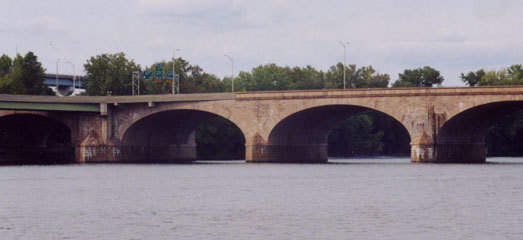Updated Sept 11, 2025
The Bulkeley Bridge, carrying I-84, US 6 and US 44 across the Connecticut River, connects Hartford and East Hartford. It's the oldest river crossing in the Hartford area, and is preceded by an older bridge that burned down in 1895.
 West side of Bulkeley Bridge and I-91 ramps, seen from foot of Founders Bridge on the East Hartford Side. The sign gantry is on I-84 west. The flyover at left leads to I-91 north. Photo taken Sept. 2002 by Kurumi.
West side of Bulkeley Bridge and I-91 ramps, seen from foot of Founders Bridge on the East Hartford Side. The sign gantry is on I-84 west. The flyover at left leads to I-91 north. Photo taken Sept. 2002 by Kurumi.
Morgan G. Bulkeley (1837 - 1922) was mayor of Hartford (1880-1888), then governor of Connecticut (1889-1893) and a U. S. Senator (1905-1911).
But that's not all: Bulkeley was also president of the Hartford Dark Blues, the city's major league baseball team, in 1874 and 1875. In 1876, he was the new National League's first president, and is in baseball's Hall of Fame. In the Civil War, he served under General George McClellan with the 13th New York Volunteers.
The first substantial bridge across the Connecticut River at Hartford was the Hartford Toll Bridge, a two-lane covered bridge that opened in 1818. The 974-foot span carried horse traffic, and in 1890 trolley lines were added, connecting Hartford to East Hartford and Glastonbury. On May 17, 1895, the bridge was destroyed in a raging fire.
In 1903, work started on a new stone-arch bridge at the site. Several buildings were razed on each riverbank to create wide, landscaped approaches. The bridge opened on Oct. 6, 1908. Its nine spans were 1192 feet long in total. It was simply called the Hartford Bridge until 1922, when Morgan G. Bulkeley passed away and it was renamed in his honor.
The bridge at the time was a city street, connecting Hartford Avenue (in East Hartford) to Morgan Street (in Hartford). Hartford Avenue is now Connecticut Boulevard. Morgan Street still exists, but is split in two and overshadowed (literally) by I-84.
Until 1942, the Bulkeley was the only motor vehicle bridge across the Connecticut River between Warehouse Point and Middletown, and handled a lot of cross-state traffic: US 5, US 6, and US 44; and earlier routes 17 and 101.
Congestion on city streets and the Bulkeley Bridge led the state to build an expressway bypass route and a new crossing, the Charter Oak Bridge, to the south. The traffic relief on the Bulkeley was short-lived, however, for much more significant changes were in the wings.
The city of Hartford had planned an east-west expressway near the city center since the 1940s: this would eventually become Interstate 84. A north-south highway -- future Interstate 91 -- would follow the bank of the Connecticut River, and after several alternatives were discussed, it was decided that these two interstates would meet at the western side of the Bulkeley Bridge, and that I-84 would use the bridge to cross into East Hartford.
In 1964, the bridge was widened to eight lanes, and commuters probably wish planners had gone for twelve: two lanes in each direction are auxiliary, serving exits and entrances, leaving only two lanes in each direction for thru traffic on I-84.
At least the Bulkeley Bridge has some company now: in the late 1950s, three new bridges were built in the Hartford area. From south to north, riverboats pass underneath the Putnam Bridge (Route 3, cancelled I-491); the Charter Oak (US 5/Route 15); the Founders (Route 2), the Bulkeley, and the Bissell (I-291).
For a brief time – from Jan. 1, 1958, to Oct, 1, 1959 – tolls were collected on the bridge. This helped finance construction of the Putnam, Founders, and Bissell Bridges.
The text from "Connecticut's Historic Highway Bridges" reads:
"Hartford's civic and business leaders were determined that the new bridge would be 'an ornament to the city which should endure forever.' ... [The] architect and engineer studied numerous ancient European bridges, and they decided that uncomplicated geometry and restrained architectural detailing would create the proper sense of "strength, beauty and dignity." The Bulkeley Bridge's tremendous scale, plain but graceful lines, arched form, and simple Classical ornament make it one of the state's pre-eminent examples of Neo-Classical architecture."
Very little of the Bulkeley's artistic value can be appreciated from the lanes on Interstate 84; and for many, the less time spent on that highway, the better. But thanks to Riverfront Recapture and other agencies and helpers, parks and trails are being built on both sides of the Connecticut River, incidentally offering great views of the bridges.
For some reason, the name "Bulkeley" is hard to type and easy to misspell. Also, Connecticut had two other 19th-century major league teams, in New Haven and Middletown.